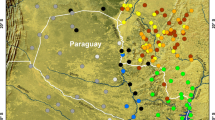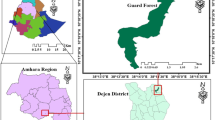Abstract
The present study compares the vegetation characteristics of two large forested and one large non-forested solution dolines in Hungary. We investigated the species composition and vegetation pattern along north to south transects (across the doline bottoms) and compared the richness of different species groups (dry and wet groups) on the doline slopes. We applied linear regression models for each slope to explore the effects of topography on species richness, and Detrended Correspondence Analysis (DCA) to detect the major gradients of floristic variation within each site. We found that the vegetation changed significantly along all transects; and, regardless of the vegetation cover, the doline bottoms contained several cool-adapted species. Variations within the two species groups were more pronounced on the south-facing slopes. The changes were similar in the forested dolines, indicating the role of forest cover in maintaining many cool-adapted species on the north-facing slopes as well. However, the number of cool-adapted species increased significantly along both slopes of the non-forested doline from the upper edge to the bottom. Contrary to our expectations, the species turnover along the slopes of the non-forested doline was lower than that along the slopes of the forested ones. We conclude that both the forested and non-forested dolines serve as refuges for many plant species adapted to different environmental conditions. Apart from providing an understanding of population patterns along environmental gradients, our results may also contribute to our understanding of an even more fundamental question for a future research agenda: the probable effects of climate change on vegetation characteristics in climatic islands with environmental conditions substantially different from the surrounding areas.
Similar content being viewed by others
References
Antonić O., Kušan V. & Hrašovec B. 1997. Microclimatic and topoclimatic differences between the phytocoenoses in the Viljska Ponikva Sinkhole, Mt. Risnjak, Croatia. Hrvatski Meteorološki Časopis 32: 37–49.
Armesto J.J. & Martínez J.A. 1978. Relations between vegetation structure and slope aspect in the Mediterranean region of Chile. J. Ecol. 66: 881–889.
Bacsó N. & Zólyomi B. 1934. Mikroklíma és növényzet a Bükkfennsíkon. Időjárás 38: 177–196.
Bárány-Kevei I. 1998. Connection between morphology and ecological factors of karst dolines (Aggtelek Hills, Hungary). Suppl. Geogr. Fis. Dinam. Quat III, T. 4-1998. 115–119.
Bárány-Kevei I.1999. Microclimate of karstic dolines. Acta Climatologica 32–33: 19–27.
Bartha A. 1933. Szakosztály ügyek — Dracocephalum ruyschiana a Bükk hegységben. Bot. Közl. 30: 114.
Bátori Z., Csiky J., Erdős L., Morschhauser T., Török P. & Körmöczi L. 2009. Vegetation of the dolines in Mecsek Mountains (South Hungary) in relation to the local plant communities. Acta Carsologica 38: 237–252.
Bátori Z., Csiky J., Farkas T., Vojtkó E.A., Erdős L., Kovács D., Wirth T., Körmöczi L. & Vojtkó A. 2014a. The conservation value of karst dolines for vascular plants in woodland habitats of Hungary: refugia and climate change. Int. J. Speleol. 43: 15–26.
Bátori Z., Gallé R., Erdős L. & Körmöczi L. 2011. Ecological conditions, flora and vegetation of a large doline in the Mecsek Mountains (South Hungary). Acta Bot. Croat. 70: 147–155.
Bátori Z., Körmöczi L., Erdős L., Zalatnai M. & Csiky J. 2012. Importance of karst sinkholes in preserving relict, mountain and wet woodland plant species under sub-Mediterranean climate: a case study from southern Hungary. J. Cave Karst Stud. 74: 127–144.
Bátori Z., Lengyel A., Maróti M., Körmöczi L., Tölgyesi Cs., Bíró A., Tóth M., Kincses Z., Cseh V., Erdős L. 2014b. Microclimate-vegetation relationships in natural habitat islands: species preservation and conservation perspectives. Időjárás 118: 257–281.
Beck v. Mannagetta G. 1906. Die Umkehrung der Pflanzenregionen in den Dolinen des Karstes. Sitzungsberichte der Kaiserliche Akademie der Wissenschaften in Wien 65: 3–4.
Borhidi A., Kevey B. & Lendvai G. 2012. Plant communities of Hungary. Akadémiai Kiadó, Budapest, 544 pp.
Dakskobler I., Sinjur I., Veber I. & Zupan B. 2008. Localities and sites of Pulsatilla vernalis in the Julian Alps. Hacquetia 7: 47–69.
Dobrowski S.Z. 2011. A climatic basis for microrefugia: the influence of terrain on climate. Glob. Change Biol. 17: 1022–1035.
Egli B.R. 1991. The special flora, ecological and edaphic conditions of dolines in the mountains of Crete. Botanica Chronica 10: 325–335.
Erdős L., Méri Á., Bátori Z., Gallé R. & Körmöczi L. 2012. Northsouth facing vegetation gradients in the Villány Mts: a case study on the population and the community level. Pakistan J. Bot. 44: 927–932.
Gargano D., Vecchio G. & Bernardo L. 2010. Plant-soil relationships in fragments of Mediterranean snow-beds: ecological and conservation implications. Plant Ecol. 207: 175–189.
Geiger R., 1950. Das Klima der bodennahen Luftschicht: Ein Lehrbuch der Mikroklimatologie. Die Wissenschaft, 4. Verlag F. Vieweg and Sohn, Braunschweig, 460 pp.
Hammer Ø., Harper D.A.T. & Ryan P.D. (2001). PAST: Paleontological Statistics Software Package for Education and Data Analysis. Palaeontol Electron, http://palaeo-electronica.org/2001_1/past/issue1_01.htm
Hampe A. & Jump A.S. 2011. Climate relicts: Past, present, future. Annu. Rev. Ecol. Evol. Syst 42: 313–333.
Hicks R.R. & Frank P.S. 1984. Relationship of aspect to soil nutrients, species importance and biomass in a forested watershed in West Virginia. For. Ecol. Manage. 8: 281–291.
Hill M.O. & Gauch H.G. 1980. Detrended correspondence analysis: an improved ordination technique. Vegetatio 42: 47–58.
Horvat I. 1953. Vegetacija ponikava. Geografski Glasnik 14–15: 1–5.
Hutchins R.B., Blevins R.L., Hill J.D. & White E.H. 1976. The influence of soils and microclimate on vegetation of forested slopes in Eastern Kentucky. Soil Sci. 121: 234–241.
Jakucs L. 1971. A karsztok morfogenetikája. Akadémiai Kiadó, Budapest, 310 pp.
Jakucs P. & Jurko A. 1967. Querco petraeae-Carpinetum waldsteinietosum, eine neue Subasszoziation aus dem slowakischen und ungarischen Karstgebiet. Biologia 22: 321–335.
Kevey B. 1997. A Nyugati-Mecsek szurdokerdei (Scutellario altissimae-Aceretum (Horvát A. O. 1958) Soó et Borhidi in Soó 1962), pp. 75–79. In: Borhidi A. & Szabó L.Gy. (eds), Studia Phytologica Jubilaria. Dissertationes in honorem jubilantis Adolf Olivér Horvát Doctor Academiae in annoversario nonagesimo nativitatis 1907–1997, Pécs, Hungary.
Kevey B. & Borhidi A. 1998. Top-forest (Aconito anthorae-Fraxinetum orni). A special ecotonal case in the phytosociological system (Mecsek Mts., South Hungary). Acta Bot. Hung. 41: 27–121.
Király G. (ed.) 2007. Vörös lista. A magyarországi edényes flora veszélyeztetett fajai. Saját kiadás, Sopron, 73 pp.
Király G. (ed.) 2009. Új magyar füvészkönyv. Aggteleki Nemzeti Park Igazgatóság, Jósvafő, 616 pp.
Kutiel P. & Lavee H. 1999. Effect of slope aspect on soil and vegetation properties along an aridity transect. Isr. J. Plant Sci. 47: 169–178.
Lazarević P., Lazarević M., Krivošej Z. & Stevanović V. 2009. On the distribution of Dracocephalum ruyschiana (Lamiaceae) in the Balkan Peninsula. Phytologia Balcanica 15: 175–179.
Lehmann A. 1970. Tarvágás által okozott ökológiai változások az abaligeti karszton. Pécsi Műszaki Szemle 25: 15–21.
Marosi S. & Somogyi S. (eds) 1990. Magyarország kistájainak katasztere I–II. MTA Földrajztudományi Kutató Intézet, Budapest, 479 pp.
Nagy J. 2004. Scree forests (Mercuriali-Tilietum) of the Börzsöny Mountains, Hungary. Acta Bot. Hung. 46: 319–336.
Özkan K., Gulsoy S., Mert A., Ozturk M. & Muys B. 2010. Plant distribution-altitude and landform relationships in karstic sinkholes of Mediterranean region of Turkey. J. Environ. Biol. 31: 51–61.
R Development Core Team. 2009. R: A Language and Environment for Statistical Computing. R Foundation for Statistical Computing, Vienna. www.R-project.org
Redžić S., Barudanović S., Trakić S. & Kulijer D. 2011. Vascular plant biodiversity richness and endemo-relictness of the karst mountains Prenj, Čvrsniva and Čabulja in Bosnia and Herzegovina (W. Balkan). Acta Carsologica 40: 527–555.
Ujvárosy A. 1998. Földrajzi helyzet, éghajlati viszonyok, pp. 22–26. In: Baross G. (ed.), Az Aggteleki Nemzeti Park. Budapest, Mezőgazda Kiadó, Hungary.
Vilisics F., Sólymos P., Nagy A., Farkas R., Kemencei Z. & Hornung E. 2011. Small scale gradient effects on isopds (Crustacea: Oniscidea) in karstic sinkholes. Biologia 66: 499–505.
Vojtkó A.1994. Adatok a Bükk hegység flórájához. Bot. Közl. 81: 165–175.
Vojtkó A.2003. A Tornai-karszt töbreinek cönológiai jellegzetességei. Bot. Közl. 90: 167–168.
Webster R. 1978. Optimally partitioning soil transects. J. Soil Sci. 29: 388–402.
Whiteman C.D., Haiden T., Pospichal B., Eisenbach S. & Steinacker R. 2004. Minimum temperatures, diurnal temperature ranges, and temperature inversion in limestone sinkholes of different sizes and shapes. J. Appl. Meteorol. 43: 1224–1236.
Yannitsaros A.G., Constantinidis T.A. & Vassiliades D.D.1996. The rediscovery of Biebersteinia orphanidis Boiss. (Geraniaceae) in Greece. Bot. J. Linn. Soc. 120: 239–242.
Author information
Authors and Affiliations
Corresponding author
Rights and permissions
About this article
Cite this article
Bátori, Z., Farkas, T., Erdős, L. et al. A comparison of the vegetation of forested and non-forested solution dolines in Hungary: a preliminary study. Biologia 69, 1339–1348 (2014). https://doi.org/10.2478/s11756-014-0430-4
Received:
Accepted:
Published:
Issue Date:
DOI: https://doi.org/10.2478/s11756-014-0430-4




